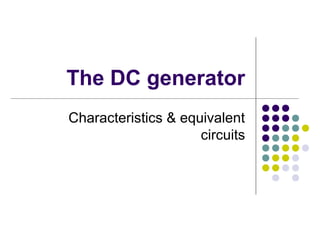
DC Generator Types, Characteristics & Circuit Analysis
- 1. The DC generator Characteristics & equivalent circuits
- 2. Types of DC generators DC Generator Self Excited Separately Excited Shunt Compound shunt series compound cumulative Differential cumulative Differential
- 3. According to the way of field excitation Separately Excited DC generator The field winding is excited from dedicated DC supply Self Excited DC generator The field winding is excited from the armature. No need of separate DC source.
- 4. According to the connection of Field winding with respect to Armature winding Shunt Generator When field winding is connected in parallel with armature winding. The field winding is termed as Shunt winding. Series Generator Field winding is connected in series with the armature. Compound Generator Both series and shunt winding are used to get combined characteristics of the above two types of generators.
- 5. The Shunt DC Generator Separately Excited- Shunt field winding is excited from a separate DC source. Self Excited – Shunt Field winding is excited from the armature voltage
- 6. Self excited shunt generator At the armature terminal, the voltage Va is given by the equation: Va= Ea-IaRa And KCL at the armature terminal node gives: Ia=IF+IL
- 7. The No Load characteristics of a DC generator The armature is run by the prime mover. There is no load connected to armature terminals while the field current is increased gradually. Since Ea=kФω and the flux Ф is proportional to the field current IF( in the linear portion of magnetizing curve), a plot between Ea and IF reflects the relation between Ea and Ф while ω is held constant by the prime mover.
- 8. The Magnetization curve or Open Circuit characteristics of a shunt Generator The characteristics curve between Ea and IF under the condition of open circuited armature is called the open circuit characteristics (OCC) or the magnetizing characteristics of a DC generator. DC generators are usually operated near the saturation( or knee) point of the OCC.
- 9. The armature residual voltage When the field winding is not excited, the armature terminal will still show some voltage as the flux does not collapse fully in ferromagmetic Field Poles. This flux is called the residual flux. This voltage is due to the residual flux in the field poles, hence termed the residual voltage Eares.
- 10. The residual voltage Eares provides current in the field winding and the flux grows. The cumulative action of field strength and voltage build up depends on several conditions. These are:
- 11. Conditions for voltage build up The presence of residual flux. If there is no residual voltage, the generator must first be excited from an external DC source. The process is termed Flashing of field. The field winding must be connected properly across the armature in such a way so as to strengthen the flux in the poles. Resistance of field circuit must be less than critical resistance.
- 12. Critical resistance The maximum resistance of field circuit above which no voltage build up is possible is called the critical resistance.. The field circuit includes the shunt field resistance Rsh and adjustable resistance Radj used to adjust the field current ( and hence flux Ф) i.e, RF = Rsh + Radj
- 13. The load characteristics The field winding is fully excited up to the saturation level which results in a No-load Armature terminal Voltage Va NL(i.e., Ea) The armature is then switched to load with the result a current flows in the armature circuit. This current Ia causes an internal voltage drop across the armature resistance Ra. The available voltage across the load terminal , termed VT is therefore less then internal generated voltage Ea. This is given by the equation: Va= Ea-IaRa
- 14. Effect of armature reaction In a self excited shunt generator, if there is no compensating winding to make up the loss of flux with increasing load, the armature terminal voltage drops sharply beyond the Breakdown point.
- 15. The rated armature voltage and current The armature terminal voltage Va at full load condition is the armature Rated voltage. Similarly the full load armature current is called the rated armature current. This is usually determined by the permissible temperature rise in the winding. This in turn depends on the thickness of armature coils and insulation class of the winding.
- 16. The voltage regulation It is given by the percent change in the armature terminal voltage from no load to full load condition, with respect to the rated armature voltage. V.R = VT(N.L) - VT(F.L) x 100 VT(F.L)
- 17. Example problem The generator armature voltage of a separately excited DC generator is 151 Volts at a speed of 151 Amperes when the field current is 2.8 A. a) Find the armature voltage for a field current of 2.4 A at 1450 rpm. b) find the generated voltage for a field current of 2.1 A at a speed of 1600 A. Answer: 129.43 Volts, 124.97 V,
- 18. Example problem A 50kW,250V, DC shunt generator delivers rated load at rated voltage for a generated armature voltage of 255.1 V. Assume that the armature resistance is 0.025 ohms, find the shunt field resistance and the generated armature voltage when the generator is delivering half rated load at the rated terminal voltage. Answer: 62.5 ohms,